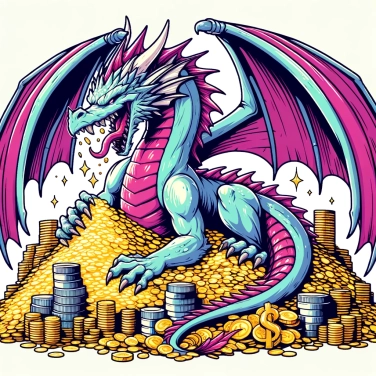Dragons love gold for several possible reasons, according to legends and stories. Among these reasons, for example, gold shines, fascinates and symbolizes wealth and power, elements that can attract these mythical creatures.

Dragons in traditional myths often hoard gold, but why prefer this metal? One hypothesis stems from the physical properties of gold: its brilliant shine, exceptional durability, and rarity make it a particularly powerful symbol of status and power. In several animal species, collecting shiny objects is common, allowing them to attract attention or display their social superiority to rivals and potential mates. Dragons may thus simply be drawn to shininess and feel an instinctive sense of satisfaction in accumulating these treasures. Culturally, in medieval and ancient legends, possessing a large amount of gold often symbolizes absolute or mystical power, thus permanently associating the image of dragons with gold.
Scientists propose some natural explanations for this curious attraction. One idea is that dragons might be instinctively fascinated by the way gold shines; just like certain animal species that are drawn to shiny objects to signal their social status or attract a mate. Gold does not tarnish; it reflects light enduringly: this might be what captures the keen gaze of dragons, known for their particular sensitivity to reflections and bright colors. Another interesting possibility is that the accumulation of valuable objects could simply stem from basic territorial behavior. Keeping substantial reserves of precious metals also serves to impress and deter rival dragons. No biologist, of course, has been able to closely study this behavior in real dragons (due to the obvious reason of their scientifically recognized non-existence). But these explanations resonate with similar behaviors observed in various terrestrial animals.
Some animals also show this attraction to shiny objects. In birds, for example, the magpie is famous for hoarding sparkling items, which it sometimes stores in its nest. Corvids, the family of crows and ravens, also enjoy collecting various things, often shiny, that they occasionally keep or exchange among themselves. And even in the oceans, the phenomenon exists: common octopuses gather all sorts of strange objects, colorful shells, pieces of polished glass, or decorative stones, to adorn their dens. These behaviors indicate that the fascination with shiny or valuable objects is not limited to imaginary creatures.
The treasures that dragons would accumulate, particularly made up of gold, can have real effects on the local ecosystem. The massive extraction of precious metals often leads to significant destruction of natural habitat, chemical pollution in soils and rivers, and the long-term weakening of certain local animal species. These metals usually lie in deep soils: going to retrieve them causes erosion, deforestation, and destruction of biodiversity in the immediate surroundings. The heavy metals released in this way can also permanently contaminate the water and nearby plants, seriously disrupting food chains. The large accumulations of metals on the surface also create a modification of local microclimates, affecting the surrounding flora and fauna in the long term.
In Norse mythology, for example, the dragon Fáfnir perfectly symbolizes this obsession with wealth: originally, it was a dwarf transformed into a dragon who jealously guarded his immense treasure, even at the cost of losing his sanity. A similar idea can be found in Greek legends with the famous guardian dragons, like the one that protects the Golden Fleece, a symbol of power and prosperity coveted by all. This one wasn't really obsessed with gold itself but was rather tasked with guarding that divine treasure. Another classic example is the legend of the medieval Western dragon, often depicted comfortably sitting on enormous piles of gold, a direct reflection of human fears about greed and the excessive accumulation of wealth. These myths often portray gold not only as a symbol of material wealth but also as representing magical or divine power, amplifying the irresistible attraction it holds over these legendary creatures.
Some scientists speculate that a theoretical animal like a dragon would probably be fond of precious metals, as these materials could reflect light and help the creature better regulate its body temperature within its lair.
The preferred precious metal of dragons varies across cultures: in China, the dragon is traditionally drawn to the dragon pearl rather than gold, with this pearl symbolizing wisdom and luck.
In the Middle Ages, dragons often symbolized human greed in European legends, their love of gold serving as a metaphor for the dangers of excessive material avarice.
In some Norse mythologies, the gold hoarded by dragons is often associated with magical or cursed powers, which explains their fierce obsession with protecting it.
Sure! Here’s the translation: "Yes, various animals such as certain birds (for example, the magpie) and mammals (such as some rodents) do indeed show an attraction to shiny objects, sometimes collecting them within their habitat to attract a mate or mark their territory."
Dragons use various means to protect their precious loot: light sleep, heightened senses, particularly smell and hearing, and of course, the most feared— a destructive ability to breathe fire or other elements when they feel their treasure is threatened.
Although dragons are fantastical creatures, several imaginary scientific hypotheses exist. One of them suggests that contact with certain precious metals could act as a catalyst for their magical or thermal energy, thus explaining their deep interest in these materials.
Generally, no. The accumulation of gold and wealth seems primarily motivated by instinctual behavior. However, according to some mythological tales, dragons might use their treasure as a nest or to attract the attention of other dragons during mating displays.
Of course! Although dragons are famous for their love of gold, their treasure may also include other precious metals such as silver, gemstones, or even rare objects that hold a particular symbolic value.

0% of respondents passed this quiz completely!
Question 1/5